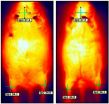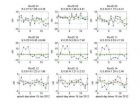(Press-News.org) The cancer death rate for men declined faster among African Americans than among whites in the latest time period, narrowing the racial disparity in overall cancer death rates, according to a new report from the American Cancer Society. But while gaps are closing for some cancers, such as lung and other smoking-related cancers and for prostate cancer, the racial disparity has widened for colorectal cancer and female breast cancer, cancers that are most affected by screening and treatment. The findings are published in Cancer Statistics for African Americans, 2013 which appears in CA: A Cancer Journal for Clinicians. The report and its consumer version, Cancer Facts & Figures for African Americans 2013-2014, provide current data on cancer incidence, mortality, survival, screening test use, and risk factors for African Americans.
The decrease in overall cancer death rates among African American males was the largest of any racial or ethnic group during the most recent time period. The reduction in overall cancer death rates since the early 1990s translates to the avoidance of nearly 200,000 deaths from cancer among African Americans.
Meanwhile, five-year relative survival rates are lower for African Americans than whites for most cancers at each stage of diagnosis. "These disparities largely reflect unequal access to health care and other socioeconomic factors," said Otis W. Brawley. M.D., American Cancer Society chief medical officer. "While cancer death rates among African American men have been declining rapidly, they remain 33% higher than those among white men, evidence that more can and should be done to accelerate this progress by making sure all Americans have equal access to cancer prevention, early detection, and state-of-the-art treatments."
The report finds that from 2000 to 2009, the overall cancer death rate declined faster among African American males than white males (2.4% vs. 1.7% per year), but similarly among females of both races (1.5% and 1.4% per year, respectively). Other findings from the report:
About 176,620 new cancer cases and 64,880 cancer deaths are expected among African Americans in 2013.
The most commonly diagnosed cancers among African American men are prostate (37% of all cancers), lung (14%), and colon and rectum (10%).
Among African American women, the most common cancers are breast (33% of all cancers), lung (13%), and colon and rectum (11%).
African American males have higher incidence rates than whites for all cancers combined (15% higher) and for the most common cancers (including prostate, lung, colorectal, kidney, and pancreas).
African American females have lower overall incidence rates than whites for all cancers combined (6% lower) and for many cancers, including the two most common: breast and lung.
Cancer death rates remain 33% higher among African American men than white men, despite the larger declines among African American men in the most recent time period.
The cancer death rate among African American women is 16% higher than that among white women, despite a 6% lower cancer incidence rate.
The higher overall cancer death rates among African Americans compared to whites is due largely to higher death rates for cancers of the breast and colorectum in women and for cancers of the prostate, lung and bronchus, and colorectum in men.
The disparity in lung cancer death rates between African American and white men has been reduced by half overall (from an excess of 50% in 1990-1992 to 26% in 2005-2009) and has been eliminated in adults younger than age 40, likely reflecting faster declines in smoking prevalence among African Americans compared to whites.
African American men have historically had higher smoking prevalence than white men, though in recent years the rates have converged. African American women have generally had slightly lower smoking prevalence than white women over the past two decades.
Smoking prevalence among high school students is markedly lower among African Americans than whites. As of 2011, 14% of African American high school boys and 7% of African American girls smoked cigarettes, compared to 22% of white boys and 19% of white girls.
Despite similar mammography screening rates, only about half (51%) of breast cancers diagnosed among African American women are diagnosed at a local stage, compared with 61% among white women. The difference has been largely attributed to a lower frequency of and longer intervals between mammograms, and a lack of timely follow-up of suspicious results.
Incidence rates for colorectal cancer are 23% higher in African American men and 22% higher in African American women compared with white men and women, respectively, and death rates are 53% higher in African American men and 46% higher in African American women, reflecting differences in risk factors, screening, and treatment. In 2010, 56% of African Americans aged 50 and older were up to date on guideline-recommended colorectal screening compared with 62% of whites.
Overweight and obesity are more common among African American women and girls than white women and girls, while there is less racial disparity among men and boys. Fifty-nine percent of African American women and 25% of African American girls are obese compared to 33% of white women and 15% of white girls.
### Facts & Figures will be posted to cancer.org/statistics after embargo.
Cancer Statistics for African Americans, 2013-2014 will be posted to cacancerjournal.com after embargo.
About the American Cancer Society
The American Cancer Society combines an unyielding passion with nearly a century of experience to save lives and end suffering from cancer. As a global grassroots force of more than three million volunteers, we fight for every birthday threatened by every cancer in every community. We save lives by helping people stay well by preventing cancer or detecting it early; helping people get well by being there for them during and after a cancer diagnosis; by finding cures through investment in groundbreaking discovery; and by fighting back by rallying lawmakers to pass laws to defeat cancer and by rallying communities worldwide to join the fight. As the nation's largest non-governmental investor in cancer research, contributing about $3.4 billion, we turn what we know about cancer into what we do. As a result, more than 11 million people in America who have had cancer and countless more who have avoided it will be celebrating birthdays this year. To learn more about us or to get help, call us any time, day or night, at 1-800-227-2345 or visit cancer.org.
Cancer in African Americans: Gap closing for some sites; Widening for others
Drop in overall mortality means nearly 200,000 cancer deaths avoided in African Americans since 1990
2013-02-05
ELSE PRESS RELEASES FROM THIS DATE:
Evidence that at least 1 mammal can smell in stereo
2013-02-05
Most mammals, including humans, see in stereo and hear in stereo. But whether they can also smell in stereo is the subject of a long-standing scientific controversy.
Now, a new study shows definitively that the common mole (Scalopus aquaticus) – the same critter that disrupts the lawns and gardens of homeowners throughout the eastern United States, Canada and Mexico – relies on stereo sniffing to locate its prey. The paper that describes this research, "Stereo and Serial Sniffing Guide Navigation to an Odor Source in a Mammals," was published on Feb. 5 in the ...
Using single quantum dots to probe nanowires
2013-02-05
Modern telecommunications happens because of fast electrons and fast photons. Can it get better? Can Moore's law---the doubling of computing power ever 18 months or so---be sustained? Can the compactness (nm-scale components) of electronics be combined with the speed of photonics? Well, one such hybrid approach is being explored at the Joint Quantum Institute (*), where scientists bring together three marvelous physics research fields: microfluidics, quantum dots, and plasmonics to probe and study optical nanostructures with spatial accuracy as fine as 12 nm. ...
Fighting fat with fat: Stem cell discovery identifies potential obesity treatment
2013-02-05
February 5, 2013—Ottawa—Ottawa scientists have discovered a trigger that turns muscle stem cells into brown fat, a form of good fat that could play a critical role in the fight against obesity. The findings from Dr. Michael Rudnicki's lab, based at the Ottawa Hospital Research Institute, were published today in the prestigious journal Cell Metabolism.
"This discovery significantly advances our ability to harness this good fat in the battle against bad fat and all the associated health risks that come with being overweight and obese," says Dr. Rudnicki, a senior scientist ...
Mammogram every 2 years has same benefit as yearly mammogram for older women, UCSF study finds
2013-02-05
Among older women, getting a mammogram every two years was just as beneficial as getting a mammogram annually, and led to significantly fewer false positive results, according to a study led by UC San Francisco.
The national study of more than 140,000 women between the ages of 66 and 89 appears online February 5, 2013, in the Journal of the National Cancer Institute.
"Screening every other year, as opposed to every year, does not increase the probability of late-stage breast cancer in older women," said lead author Dejana Braithwaite, PhD, a UCSF assistant professor ...
Cargo container research to improve buildings' ability to withstand tsunamis
2013-02-05
Anyone who has seen the movie "Impossible" or watched footage from the Japanese tsunami has learned the terror that can strike with little warning. In those cases, when there is no time to flee, there may still be time to reach higher ground, called vertical evacuation.
But as you race to the third floor, how do you know if the building will hold up? Walls of water are not the only danger. Another potentially lethal challenge is water-driven debris - such as 60,000-pound fully loaded cargo containers - transformed into projectiles. Often pulled behind semi-trucks on highways, ...
Olive oil component alleviates intestinal ischemia and reperfusion
2013-02-05
Here's another reason why you should include olive oil in your diet: A new research report published in the Journal of Leukocyte Biology suggests that at least one compound in olive oil significantly reduces intestinal ischemia (restricted blood supply) and the resulting reperfusion injury (tissue damage caused when blood supply returns). The compound, called "oleuropein aglycone," is the most prominent polyphenol found in olive oil and could become a novel therapeutic target aimed at treating intestinal ischemia and reperfusion injury in humans. Ultimately, this research ...
Flexible classroom design saves money, improves flexibility, accessibility of instruction
2013-02-05
Researchers at North Carolina State University have developed a classroom design that gives instructors increased flexibility in how to teach their courses and improves accessibility for students, while slashing administrative costs.
Specifically, the new classrooms take advantage of the fact that students are bringing their own technology – such as laptops – to class. The classrooms also include mobile infrastructure, where whiteboards, desks and tables can be reconfigured according to the needs of students and instructors.
"These classrooms work really well in terms ...
Chest pain prior to a heart attack can protect the heart
2013-02-05
MINNEAPOLIS, MN – Feb. 5, 2013 – Patients who experience chest pain in the 24 hours preceding a heart attack, also called preinfarction angina, have smaller heart attacks and improved cardiac function in the contemporary cardiac stenting era, researchers found in a study published Jan. 22 in Circulation: Cardiovascular Interventions.
"Even before we began treating heart attack patients with angioplasty and stenting, physicians recognized that patients with chest pain prior to their heart attack seem to have better outcomes," says the study's senior author, Jay H. Traverse, ...
Precise Point Positioning and real-time positioning accuracy for COMPASS satellite navigation
2013-02-05
COMPASS uses the Geostationary Earth Orbit (GEO) and Inclined Geosynchronous Satellite Orbit (IGSO) satellites, which are more suitable for regional services. Its constellation is composed of 14 satellites, including 5 GEO, 5 IGSO satellites and 4 Medium Earth Orbit (MEO) satellites. As of 2012, 13 satellites have been launched. Except for G2 (unusable) and M1 (testing only), the remaining 11 satellites, including 4GEO+5IGSO+2MEO, have successfully transmitted signals and broadcasted navigational messages, to prepare for full operation starting in 2013.
Positioning accuracy ...
The zebrafish revealed a central regulator for the development of the brain histamine system
2013-02-05
Research has shown that mutations in the psen1 gene are common in the familial forms of Alzheimer's disease, and the Presenilin-1 protein that the gene encodes is known to be involved in the cleavage of the amyloid precursor protein. In Alzheimer's disease the amyloid precursor protein is not cleaved the normal way, and the protein accumulates in the brain damaging neuronal tracts and neurons. It is still unknown if the psen1 gene is involved in the etiology of Alzheimer's disease via another mechanism.
Professor Pertti Panula's research team at the University of Helsinki ...
LAST 30 PRESS RELEASES:
Study showcases resilience and rapid growth of “living rocks”
Naval Research Lab diver earns Office of Naval Research 2025 Sailor of the Year
New Mayo-led study establishes practical definition for rapidly progressive dementia
Fossil fuel industry’s “climate false solutions” reinforce its power and aggravate environmental injustice
Researchers reveal bias in a widely used measure of algorithm performance
Alcohol causes cancer. A study from IOCB Prague confirms damage to DNA and shows how cells defend against it
Hidden viruses in wastewater treatment may shape public health risks, study finds
Unlock the power of nature: how biomass can transform climate mitigation
Biochar reshapes hidden soil microbes that capture carbon dioxide in farmland
Reducing saturated fat intake shows mortality benefit, but only in high-risk individuals
Manta rays create mobile ecosystems, study finds
Study: Mixed results in using lipoic acid to treat progressive multiple sclerosis
Norbert Holtkamp appointed director of Fermi National Accelerator Laboratory
New agentic AI platform accelerates advanced optics design
Biologists discover neurons use physical signals — not electricity — to stabilize communication
Researchers discover that a hormone can access the brain by hitchhiking
University of Oklahoma researcher awarded funding to pursue AI-powered material design
Exploring how the visual system recovers following injury
Support for parents with infants at pediatric check-ups leads to better reading and math skills in elementary school
Kids’ behavioral health is a growing share of family health costs
Day & night: Cancer disrupts the brain’s natural rhythm
COVID-19 vaccination significantly reduces risk to pregnant women and baby
The role of vaccination in maternal and perinatal outcomes associated with COVID-19 in pregnancy
Mayo Clinic smartwatch system helps parents shorten and defuse children's severe tantrums early
Behavioral health spending spikes to 40% of all children’s health expenditures, nearly doubling in a decade
Digital cognitive behavioral treatment for generalized anxiety disorder
Expenditures for pediatric behavioral health care over time and estimated family financial burden
Air conditioning in nursing homes and mortality during extreme heat
The Alps to lose a record number of glaciers in the next decade
What makes a good proton conductor?
[Press-News.org] Cancer in African Americans: Gap closing for some sites; Widening for othersDrop in overall mortality means nearly 200,000 cancer deaths avoided in African Americans since 1990




